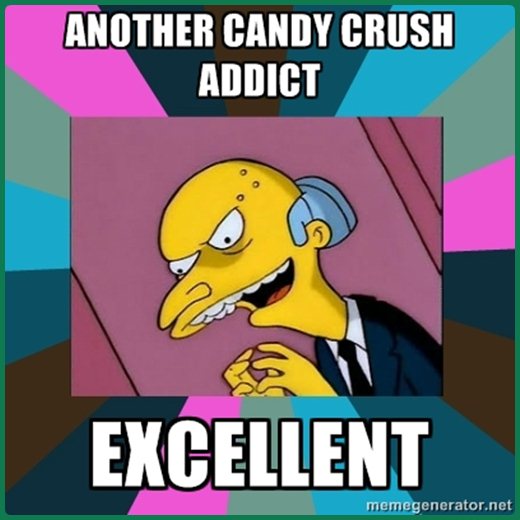Are you fed up with annoying Candy Crush invitations? I thought we grew past that when we stopped playing Farmville. It’s been a decade since Facebook came around, It’s been 7 or so years since Facebook let you send annoying invitations to your friends, yet companies are still desperately trying to “bribe us to spam our friends.”
At what point do we finally realize that marketing shouldn’t mix with social media?
This pretty much sums up most social media marketing strategy today…
“Bribe your customers to spam their friends!”
Every contest, fan-gating, and even content distribution strategy is essentially forcing conversation that in no way, shape, or form improves how people feel about you, your brand or even remotely makes them trust you and/or want to buy from you.
Social Media by definition is a communication tool to enable one-on-one conversations around a single point of interest (i.e. a picture, video, topic, viewpoint, event or entity) at scale. Even when more than one person joins the conversation, it is still a bunch of one-on-one conversations happening in tandem.
There is a reason no one has managed to truly monetize social media. There is a reason brands have given up on direct response success in social media and choose instead to use it as a content distribution channel and/or resort to gimmicks to prop up vanity metrics that don’t drive bottom line results.
The simple reality is that the very nature of social media is the antithesis of marketing. (I use marketing in this context to mean push marketing or broadcast media.)
Contrary to popular belief, brands should not be joining the conversation. Social media’s very nature is to augment communication between friends. It’s a way of having conversations with individuals.
When a brand “joins” the conversation, essentially they are interrupting an existing conversation and starting two new conversation, one with each side of the existing conversation.
In my book, unless I invite your brand into the conversation, you are basically spamming us. You are just being a little more deliberate in who you spam.
If you at least put a face behind your brand, you are getting closer to authentic communication, but if you are soliciting business, fans, likes, or any business agenda, you are defeating the purpose of social media, which is…socializing.
When brands bribe me to share with a contest entry or offering me a discount, the people exposed to that share see right through it. You are basically a vessel through which the brand broadcast their message. The same way marketing messages that interrupt me – annoy me, so too, social shares that incentivize the person sharing – annoy me too.
Broadcast media still works, and contests certainly drive engagement, likes, and maybe even a few sales… but it dilutes the value of the relationship. After one or two contest invites from a friend, I will start ignoring all their social posts.
Look at Groupon for example… Many years ago if you saw a great deal you “WANTED” to invite your friends. Why? for starters, when you share an amazing deal with a friend, they appreciate you for it. There were also two social elements built into the mechanism. First, you needed a certain amount of participants to tip the deal and make it happen and most of the original deals were experiences that you would want to share with your friends, like going to a cupcake baking class. Still, what drove success with that social sharing was primarily the social credibility you scored by letting your friends in on a secret deal they didn’t know about . Eventually though, the deals were no longer a novelty because we could always find a similar deal on one of the hundreds of daily deal sites. The deals were no longer social experiences, but moved into goods, online products, etc…The deals were no longer time sensitive that required a tipping point. All in all, the model was great until it diluted too much social credibility and capital. Now, I will pretty much ignore any invite for a daily deal. I would also never dream of inviting my friends. It is so yesterday and old.
Worse still, if I ever need an oil change, or a massage, or any other common Groupon-esque deal, I just got to Yipit and find it. Much like Macy’s, I would never buy anything retail there because everything is always on sale.
A great discount, without a good reason for existing sends the message that you can afford to give that discount all the time, and paying full retail would be a ripoff.
Most importantly though, It no longer makes me feel good to share a Groupon deal. My friends no longer appreciate me bringing it to their attention because the deals are no longer awesome, no longer exclusive, and no longer a novelty.
You want the honest truth?! The truth no marketer wants to admit to you?
Social Media is not the place for marketing.
The promise of reaching mass amounts of people. The dream of spreading virally. The pat on the back from drumming up vanity metrics… Those all blind us from the truth.
Social and Marketing simply don’t mix!
Hold your horses though, this doesn’t mean brands don’t belong there, it just means they need to stop thinking about marketing in a social media context. Hang tight, I’ll explain soon.
If your customer service team uses social media to solve customer problems, that is getting closer to authentic one on one conversations, but the benefits you are seeking are secondary. The conversation is authentic and natural, but the marketing agenda behind it, of having other people see the conversation, is far from the holy grail of capitalizing on the value created in social media.
There are two current camps when it comes to social media strategy for business.
A) Pay to Play and bribe customers to engage.
B)Branding and content distribution, and call it “top of the funnel” to justify not driving a return on investment.
Here’s the rub though…
There are already tons of conversations happening in social media around your brand. Users are sharing experiences, pictures and videos about you and your company even when you are not involved in the conversation. (especially when you are not involved.)
The general feeling around these interactions is that they are opportunities to “Join/Spam the conversation.”
Technically, they are opportunities, but you need to take a step back and ask a couple of questions first.
1. Why are they sharing in the first place? What are you doing and what can you do to foster more natural and native sharing?
2. How can you capture and activate the value created around this sharing without spamming the conversation and without diluting the social capital those users have with their friends.
Think about it this way. For each social share that happens naturally around your brand, that user probably has 150 followers or friends, of those friends, maybe 25-50 will actually see the share/message, maybe 10 of them actually value the opinion of the sharer, and of those 10, maybe 2-3 are viable prospects that might one day buy from you because their friend refers them.
This might sound like nothing, especially in the face of getting thousands of likes, etc… but, if you think about it, this is a chance to drive 2x-3x the business you currently have. In fact, it’s a chance to recruit and win over the hearts and minds of the most loyal customers you can possibly find.
If only there was a way to turn those 2-3 people or even more into immediate customers? Feeding off the social proof when it’s freshest in everyone’s mind.
Let’s get one thing straight, Social Media is a One-on-One game.
It is not about numbers or going viral, it is about fostering sharing, and driving individual referrals one loyal customer at a time.
So, back to our two key questions –
1. How do you drive more natural sharing? – Well, this is obvious as Gary Vaynerchuck preaches, “WOW your customers to the point where they can’t help but gush about you on social media.”
People share because it makes them feel good inside. They want validation, approval, and appreciation from their friends.
(Who Doesn’t want to feel appreciated?)
Make your customers feel special and they will share their experience with their friends.
2. The more important question, how to capture and activate that sharing without spamming the conversation? This is a bit trickier, but I think I have a formula that works. It goes back to the first question of how to get users to naturally share your brand.
Let’s refocus these questions into one fundamental and core question, “How Do We Get Customers To Want To Share Us With Their Friends in a Way That Their Friends Appreciate The Sharer and at the Same Time Encourages The Friends To Want To Take Immediate Action and Buy?”
In other words, if you can find a way to make a customer feel special while referring their friends to you (as opposed to diluting their capital by bribing them) you will have cracked the code for capitalizing on social media.
This isn’t a unicorn strategy. I can’t stop telling everyone who will listen about how awesome Uber is. I am a massive evangelist of Uber. Why? because they take friction out of my life and any friend that tries them, loves me for introducing them to Uber. Uber has a refer a friend program using the give and get model. Share with your friends and you get $10 and they get $10. Guess how many times I used that share a friend opportunity? ZERO.
Why? because I genuinely want my friends to experience Uber so much that I can’t wait for the time to find the link and share it.
The most valuable social sharing that happens is the sharing you are itching to get out there and you just rush to post it. You can’t wait to tell all your friends about this awesome new thing that will make them think you are super cool and love you for it.
You can’t help but share it. You have no choice. You are compelled to act ASAP!
I would not call this marketing. I would call this Experience Design. If you can design an experience that makes customers look good by driving direct referrals, you have the holy grail of social media.
Stop thinking about marketing in social media. Stop thinking about Engaging on social media…
START THINKING ABOUT INSPIRING CONVERSATIONS ON SOCIAL MEDIA…
CONVERSATION THAT WILL DRIVE DIRECT REFERRALS.
———————————————————————-
If you are sick and tired of being marketed to on social media and want to join the Unmarketing Revolution, I am working on a stealth project to help brands drive more referrals in a native and organic way. If you are interested, please opt in to the beta test. Here’s The Link.



 Click Images To Verify
Click Images To Verify

I have to admit that I was a bit surprised when I saw this post, because it seemed to me that social media marketing had just become an inevitable part of social media. Like, it’s there now and it always will be. Then I thought about it a little more and made a point to work out how much of an affect it had on me. If people send me a gaming request, I ignore it. If I’m playing games and need to send a request to continue, I send it to a side Facebook account that I made for the purpose of not annoying my friends. All the adds on the side of my browser I actively ignore, and I do the same with other social platforms as well. But, you’re right about natural sharing. If I thought something was great, chances are I’ll post about it on Facebook (I’m part of that generation) or talk about it to my friends. When I’m following pages, it’s the genuine posts and pictures that I will share over that page plugging their product/blog/service. You’ve brought something else to my attention to which I didn’t think about before, which is that I (as a person who wants to make a living over the internet) don’t have to spam my product through social media. I’ve just said that I ignore those kinds of posts and notifications, and I do, but the presence of social media advertising has basically gotten me so immune to it that I would easily have added myself into this category and not in any way actually aided to its death. Thank you for the reminder of how ineffective it can truly be and how I can actually do better just by being even the tiniest bit more creative than Candy Crush and Farmville (which, sadly, my mother still does play).
I have to question how effective Social Media Marketing actually is. It obviously works in some cases because people keep doing, but as someone who just finds the whole endeavor annoying because I hate advertisement clogging up my Facebook and Twitter feeds, I have to agree with you. It is time to kill Social Media Marketing. I think the effort spent with attempts at plugging/spamming would be much better spent focusing on building a better customer relationship and igniting discussion, and that’s just some things. And the bane of my existence is when I actually get into a facebook game and have to send notifications to people, which they inevitably ignore and I’m unable to progress to the next level.